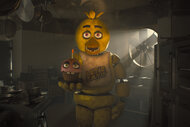Create a free profile to get unlimited access to exclusive videos, sweepstakes, and more!
Awards Contender: The scary secrets behind Carnival Row, The Twilight Zone, and The Terror

Welcome to Awards Contenders. This month, SYFY WIRE is talking to the actors, directors, designers, and craftspeople whose work was featured in the best movies and TV offerings of 2019, and who are now the leading awards nominees. Today, we're speaking with the ASC-nominated cinematographers of The Twilight Zone, The Terror: Infamy, and Carnival Row.
Using only shadow and light, the director of photography creates atmosphere, suggests time, and makes a whole artificial world seem real. We talked to three master cinematographers about how they used composition, focus, framing, and lighting to enhance these television series:
THE TWILIGHT ZONE
At first, the Blurryman who appears in cinematographer Craig Wrobleski's nominated episode "Blurryman" was called the Shadowyman, and it wasn't immediately apparent that he would ultimately turn out to represent the late Twilight Zone creator Rod Serling. Wrobleski only knew that he needed to create a space for this mysterious figure to appear once in every episode. "We were told, 'It's something coming later, a fun sort of running easter egg element in a series full of easter eggs,'" he says. Except this one was extra meta, and spoke to the nature of the show itself.
Blurryman needed to be visually out of focus until he revealed himself to a Twilight Zone writer. To help create this effect, Blurryman's costume was made of velvet, which absorbed light in a particular way. And when the story switched from color to black and white, Wrobleski used a progressive desaturation, so the colors would bleed out one at a time, until the last color visible was red. "When we dressed the set, we figured out the rotation direction of the camera, and we made sure that the paintings were oriented so that there was always a little splash of color that was disappearing," he explains.
Wroblesksi also used optical effects to play with the notion of how focus works in film. Even though Blurryman's surroundings are always sharp and clear, the character himself is always out of focus.
"We wanted to make sure that it didn't just feel like someone pressed a button to make him sort of gauzy," Wrobleski says. "We wanted to make sure it felt like the camera was not seeing him the way it saw the rest of the scene — that he seemed to be outside of the physical world."
CARNIVAL ROW
With his nominated episode "Grieve No More," cinematographer Chris Seager takes us back in time to Philo's infancy and childhood at the Light of the Martyr Foundling Home. Shooting in an abandoned 18-century veteran's hospital in Prague known as Invalidovna, Seager took advantage of the building's high ceilings, tall windows, and long corridors to create a gothic atmosphere. "There were remarkable places, like the staircase, that created wonderful silhouettes," Seager says.
In one scene, the room is illuminated by soft light coming through two windows, wreathing Philo's face in muted light and shadow. To transition Philo from the present to the past and back again, Seager had actor Orlando Bloom sit on the camera dolly itself, so that whenever the whole dolly moved, Bloom moved with it. As Philo circles around, he becomes part of a flashback, with children playing behind him; when one kid falls on the ground and hits his head, we see the back of Philo's head, bearing the scar from that fall. It's a moment of subtle visual storytelling.
THE TERROR: INFAMY
On his nominated episode, "A Sparrow in a Swallow's Nest," cinematographer John Conroy worked with other departments to establish the aesthetic of the show – the color palette as well as the visual references. In this case, Conroy's cinematography uses the visual vocabulary and low framing style of such master Japanese filmmakers as Yasujiro Ozu and Hiroshi Teshigahara, and particularly some famous kwaidan horror movies, such as Ringu and Ju-On: The Grudge.
The key was to reference horror movies with the atmosphere, but combine the terror with beauty. "Bad things happen in beautiful places," Conroy says. The very first scene, when Masayo Furuya commits suicide, was originally written to take place at night. Conroy suggested that it might open the show better to have it take place in daylight, "since night sometimes signals to the audience that bad things are about to happen."
Conroy wound up shooting the scene over two nights during the dusky "magic hour" — which, despite the name, is really only about 20 minutes long. "It's so hard to get that light," Conroy says. "We were petrified that one night might be cloudy, and one sunny, but the lighting gods were looking down on us. It set up the whole series."


























